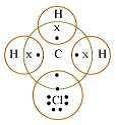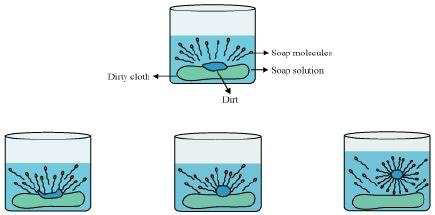1: Ethane, with the molecular formula C2H6 has
(a) 6 covalent bonds. (b) 7 covalent bonds.
(c) 8 covalent bonds. (d) 9 covalent bonds.
Ans: (b) ethane has 7 covalent bonds.
2: Butanone is a four-Carbon compound with the functional group
(a) Carboxylic acid. (b) Aldehyde.
(c) Ketone. (d) Alcohol.
Ans: (c) the functional group of butanone is ketone.
3: While cooking, if the bottom of the vessel is getting blackened on the outside, it means that
(a) the food is not cooked completely. (b) the fuel is not burning completely.
(c) the fuel is wet. (d) the fuel is burning completely.
Ans: (b) while cooking, if the bottom of the vessel is getting blackened on the outside, then it means that the fuel is not burning completely.
4: Explain the nature of the covalent bond using the bond formation in CH3Cl.
Ans: Carbon completes its octet by sharing its four electrons with other Carbon atoms or with atoms of other elements. The bonds that are formed by sharing electrons are known as covalent bonds. In covalent bonding, both the atoms share the valence electrons, i.e., the shared electrons belong to the valence shells of both the atoms. Carbon requires 4 electrons to complete its octet, while each hydrogen atom requires one electron to complete its duplet. Also, chlorine requires an electron to complete the octet. Therefore, all of these share the electrons and as a result, Carbon forms 3 bonds with hydrogen and one with chlorine.

or

5: Draw the electron dot structures for
(a) Ethanoic acid. (b) H2S.
(c) Propanone. (d) F2.
Ans:
(a) Ethanoic acid 



(b) H2S (c) Propanone (d) F2
6: What is a homologous series? Explain with an example.
Ans: It is a group of members of the same class of organic compound having similar chemical properties & they have the same general formula CnH2+2.
Eg. Alkane CnH2n+2
(1) Methane CH4
(2) Ethane C2H6
(3) Propane C3H8
7: How can ethanol and ethanoic acid be differentiated on the basis of their physical and chemical properties?
Ans:(i) Ethanol is a liquid at room temperature with a pleasant odour while Ethanoic acid has a vinegar-like smell. The melting point of Ethanoic acid is 290 k. The melting point of Ethanol is 156 k.
(ii) Ethanoic acid reacts with metal carbonates and metal hydrogen carbonates to form salt, water, and carbon dioxide gas while ethanol does not react with them.
8: Why does micelle formation take place when soap is added to water. Will a micelle be formed in other solvents such as ethanol also.
Ans. Soap molecules have 2 ends with different properties. One end is hydrophilic which dissolves in water. The other end is hydrocarbons when soap is added to water the ionic end of the soap will form a unique pattern and keep away the hydrocarbon tail. The hydrophic tail are inside the cluster and the ionic ends are at the surface. Hence a micelle is formed. Soap is soluble in ethanol hence micelle formation will not take place.
9:Why are Carbon and its compounds used as fuels for most applications?
Ans: Most of the Carbon compounds give a lot of heat and light when burnt in air. Saturated hydrocarbons burn with a clean flame and no smoke is produced. The Carbon compounds, used as a fuel, have high calorific values. Therefore, Carbon and its compounds are used as fuels for most applications.
10: Explain the formation of scum when hard water is treated with soap.
Ans: Soap does not work properly when the water is hard. A soap is a sodium or potassium salt of long chain fatty acids. Hard water contains salts of Calcium and Magnesium. When soap is added to hard water, Calcium and Magnesium ions present in water displace sodium or potassium ions from the soap molecules forming an insoluble substance called scum. A lot of soap is wasted in the process.
11: What change will you observe if you test soap with litmus paper (red and blue)? Ans: Since soap is basic in nature, it will turn red litmus blue but, the colour of blue litmus will remain blue.
12: What is hydrogenation? What is its industrial application?
Ans: Hydrogenation is the process of addition of hydrogen. Unsaturated hydrocarbons are added with hydrogen in the presence of palladium and nickel catalysts to give saturated Hydrocarbons.

This reaction is applied in the hydrogenation of vegetables oils, which contain long chains of unsaturated Carbons.
Industrial Use: It is used to convert vegetable oil into Vanaspati ghee
Vegetable Oil + H2 ——→Nj/473 X Vanaspati Ghee
13: Which of the following hydrocarbons undergo addition reactions: C2H6, C3H8, C3 H 6, C2H2 and CH4.
Ans: Unsaturated hydrocarbons undergo addition reactions. Being unsaturated hydrocarbons,
C3H6 and C2H2 undergo addition reactions.
14: Give a test that can be used to differentiate chemically between butter and cooking oil.
Ans: Butter contains saturated fats. Therefore, it cannot be hydrogenated. On the other hand, oil has unsaturated fats. That is why it can be hydrogenated to saturated fats (solids).
15: Explain the mechanism of the cleaning action of soaps.
Ans: The dirt present on clothes is organic in nature and insoluble in water. Therefore, it cannot be removed by only washing with water. When soap is dissolved in water, its hydrophobic ends attach themselves to the dirt and remove it from the cloth. Then, the molecules of soap arrange themselves in micelle formation and trap the dirt at the center of the cluster. These micelles remain suspended in the water. Hence, the dust particles are easily rinsed away by water


